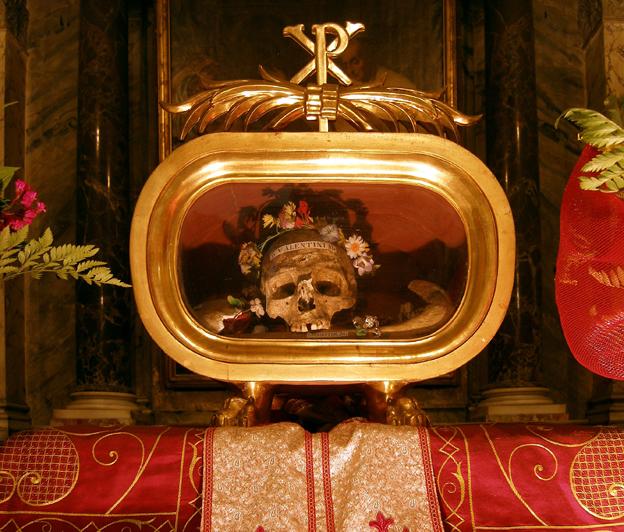On February 14th, late into the third century AD, a man by the name of Valentinus was martyred; we know this to be a fact, however the details of the man we now call St. Valentine are shrouded in mystery.
Inside Chiesa di Santa Maria in Cosmedin, on Rome’s Piazza Bocca della Verità, where the infamous ‘mouth of truth’ is situated, is a tiny glass reliquary; it is claimed that, inside it, resides the skull belonging to the man whose previous existence now perpetuates the increase in sales of greetings cards, chocolates and flowers in February.
Wearing a coronet made from flowers and with a stencilled inscription across the skull, the relic is identified as that belonging to St. Valentine, the patron saint of lovers; however, proving this is difficult.
The official Roman Catholic register of saints currently lists ten St. Valentine: one Pope Valentine and a handful of others with a variation of the name. According to the official register, the Valentine we associate with the February celebrations was a holy priest in Rome who assisted St. Marius in giving aid to the martyrs persecuted under Claudius II. The emperor summoned him to Rome and demanded he renounce his faith; when Valentine refused, he was ordered to be beaten with clubs before being beheaded on February 14.
With the fact that the bones belonging to St. Valentine have been distributed to many reliquaries around the world, the controversy surrounding Valentine’s skull continues to play out, with many scholars disputing the provenance.
The skull was discovered during an excavation of a catacomb that took place in Rome in the early 1800s; the dig yielded the skeletal remains and other relics that are now associated with St. Valentine.
The church of Santa Maria stands on the site of an ancient Roman temple dating back to the second century BC with much of what is above ground dating from the eighth and twelfth centuries.
The skull can be found in the side altar on the left of the church and, whether it is truly the remains of the saint we associate with amore, it’s a nice little piece of legend to tuck away with your memories of your trip to Rome.











